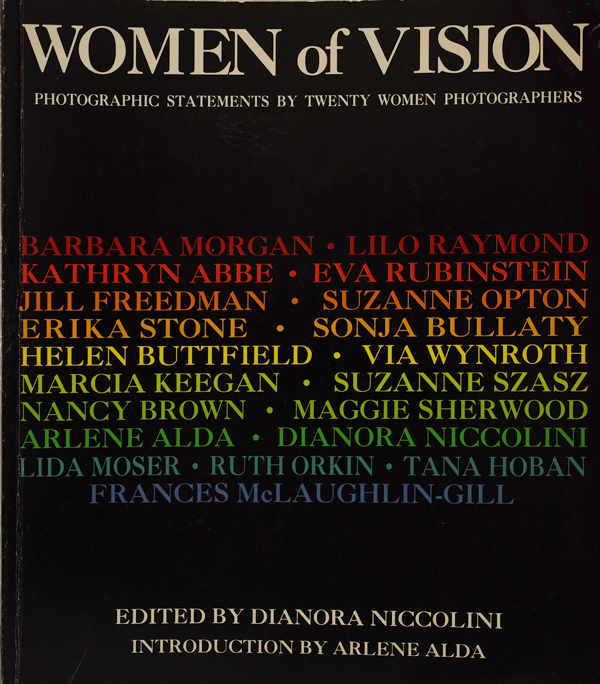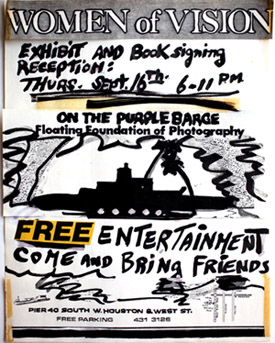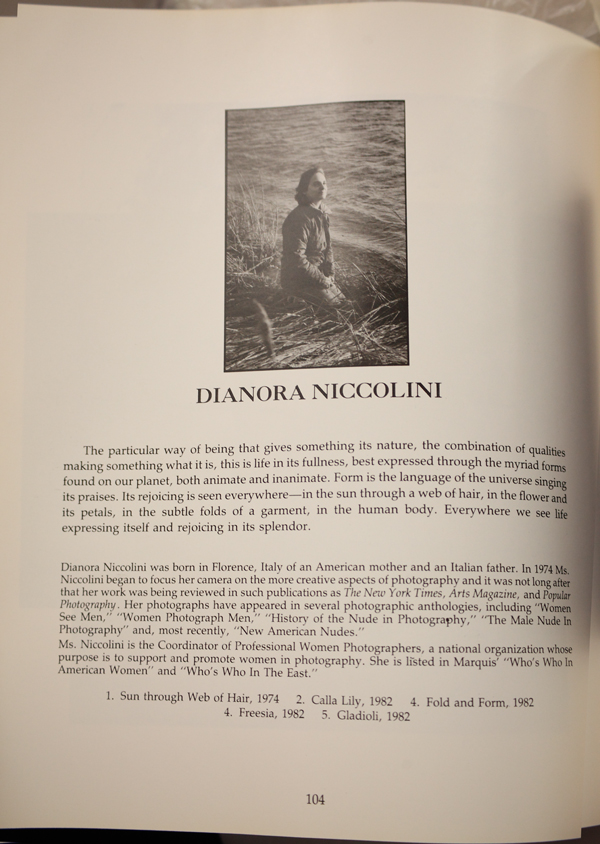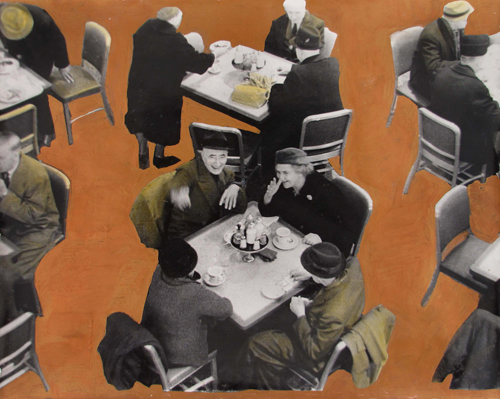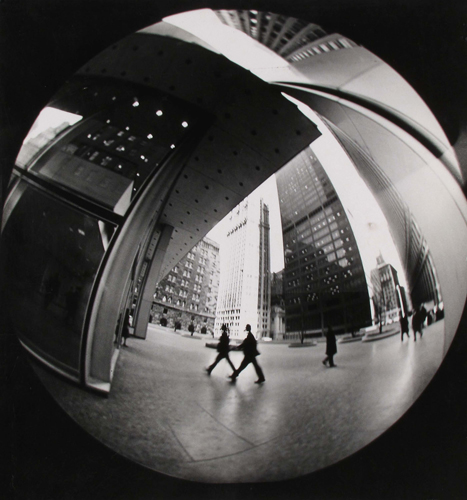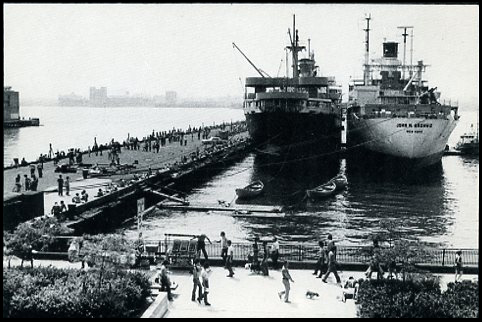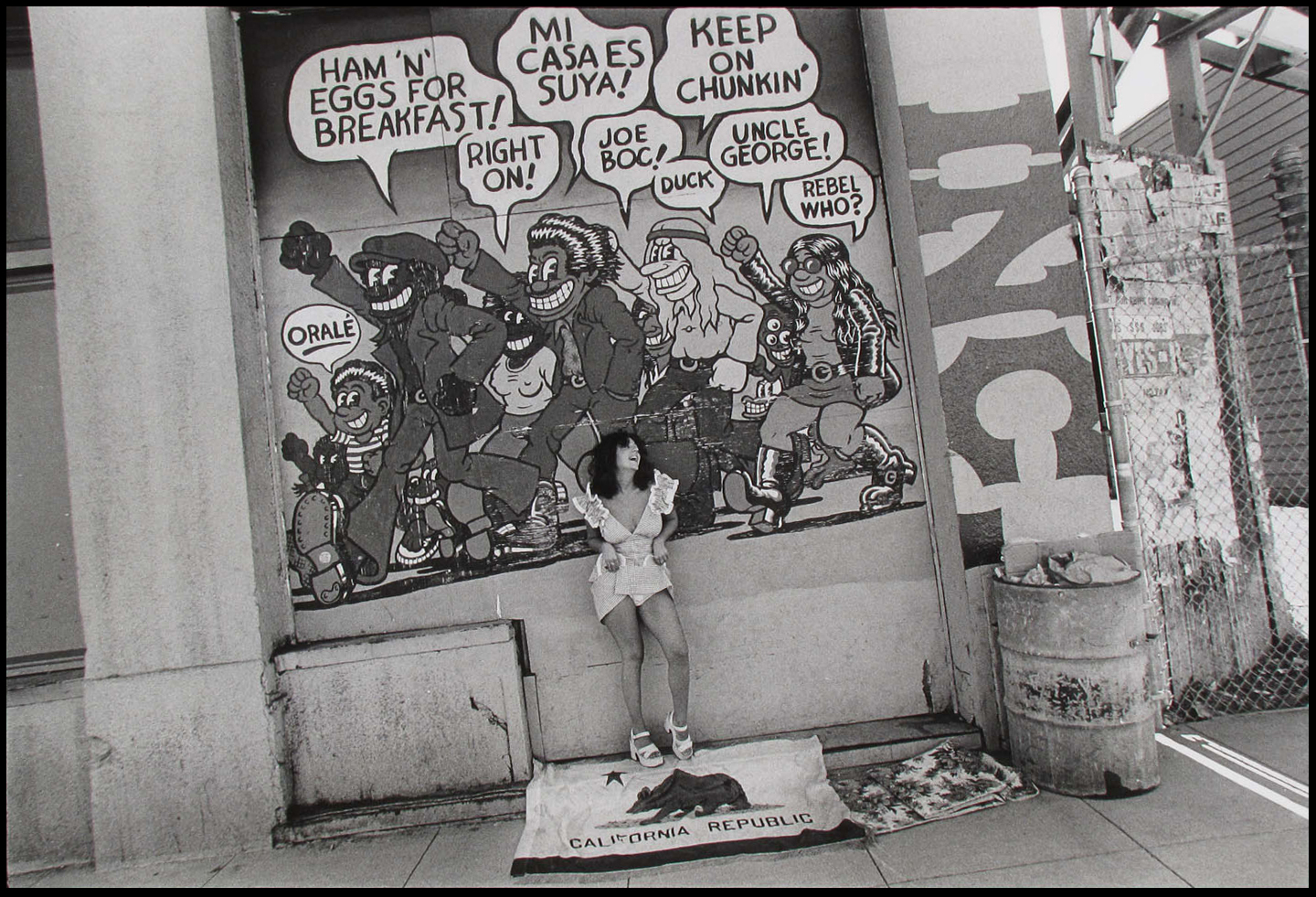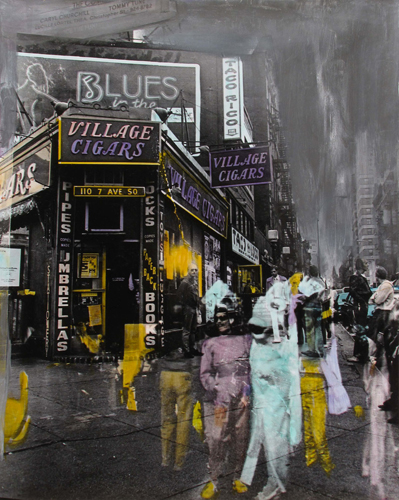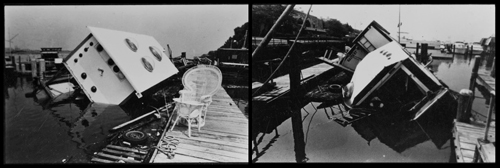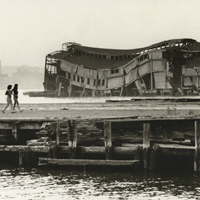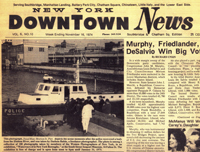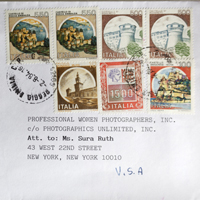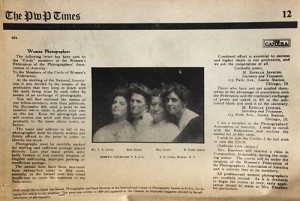Tag Archives: Floating Foundation of Photography
Of Her Time & Way Ahead: Beth Wilson on Maggie Sherwood
Through a Lens Brightly: Women, Photography & Change –
A Blog Series in Honor of Women’s History Month.
Today photography is a major force in the art world. Prints sell for thousands of dollars, and photographers like Cindy Sherman and Annie Leibovitz are global names. But there was a time, not too long ago, when things were different. In the 1960s and 70s, very few galleries featured photography. Print prices were low, and opportunities for photographers were extremely limited.
In 1969, a dynamo named Maggie Sherwood bought an old houseboat in Ocean City, Maryland, and created the Floating Foundation of Photography. Moored along Manhattan’s West Side and at various points along the Hudson, the little purple boat became a school, gallery, and gathering place for many photographers of the day. Sherwood taught classes at Sing Sing Prison (along with luminaries like Lisette Model and Eva Rubinstein), and organized al fresco shows on the New York City piers and in Central Park.
Not only did she embody the free-spirit of the 1960s and 70s, but anticipated many trends in the photographic field. She did mixed media before it was fashionable, experimented with pinhole and Diana cameras, and single-handedly engineered a social network for photographers in a day before the Internet. In 1984, Maggie Sherwood passed away from cancer, and in 1986 the boat was sold, though the Foundation lives on through the efforts of her son, Steve Schoen, and her daughter-in-law, Jone Miller.
In 2009, Beth E. Wilson curated a landmark show on Sherwood at the Samuel Dorsky Museum of Art. Wilson is an art historian, critic, and curator, with a bachelor’s degree in Philosophy from Georgetown Univeristy, and graduate degrees in Art History from Hunter College and CUNY Graduate Center, where she is completing a dissertation on the World War II work of photographer Lee Miller. She regularly teaches History of Photography, History of Film, and courses in late 19th and early 20th century art at SUNY New Paltz. Here is a conversation with her.
PWP: How did you discover Maggie Sherwood and the Floating Foundation of Photography, and what struck you most about her and the foundation?
As art critic for the Hudson Valley magazine Chronogram, I first encountered Maggie’s work in a small show organized by her son and daughter-in-law, Steve Schoen and Jone Miller, who now live in the Hudson Valley. Maggie’s work struck me as a playful, creative take on New York City in that particular time frame (mid-60s to mid-80s). Getting to know Steve and Jone was a tremendous education in itself, as they told me the whole story of how Maggie had bought the houseboat almost on a whim, and turned it into a sort of clubhouse/exhibition space for her photographer friends (including luminaries like W. Eugene Smith and Lisette Model, among others), and how Steve had developed the FFP’s photo-based education program, taking them to Sing Sing and beyond. This story seemed to be a gift that kept on giving.
PWP: Why is she important and what is her legacy today?
The whole phenomenon of Maggie (that term captures her personality particularly well) and the boat is something that obviously was terrifically important and influential on the photographers who were pulled into her orbit at the time, something that became very apparent to me as I worked on the exhibition and contacted a number of them. The sad part is that so many of these talented people have largely drifted apart since, and the story of the boat has gradually been fading away over time–something that I hope the exhibition (and now the catalogue) have done something to redress. The show became something of a little reunion for many of the photographers in it.
We sent copies of the catalogue to a number of institutions and individuals when it came out, prompting a lovely little note from Malcolm Daniels at the Metropolitan Museum of Art, thanking me for bringing to his attention a piece of New York photographic history that he hadn’t previously known about. So the question of Maggie’s legacy is something of an ongoing proposition, and still I think very unsettled. I would love to see her work, and the work of the Floating Foundation to be more widely known.
PWP: Sherwood seemed to create a social network for photographers in a time before the Internet. How did she manage to do this and what did she enable other photographers to do?
The FFP happened at a time when people still had to make the effort to get together face-to-face–you couldn’t just dial up your Facebook newsfeed to find out what was going on. Photography itself was still a very material practice, all chemistry and paper and darkrooms and film, which basically demanded that people spend some time together, looking at prints, critiquing each others’ work, etc. Maggie came of age as a serious photographer in the workshops conducted by David Vestal, in which he scrutinized the students’ prints within an inch of their lives (and he regularly registered his displeasure with any number of Maggie’s unorthodox experiments). You can’t quite do that sort of thing by swapping jpegs back and forth. The analogue basis of the medium at that time, I think, sort of demanded something like the ‘clubhouse’ environment provided by the boat.
At a time when the opportunities for gallery exhibitions of photography were very limited, the chance to show on the boat, embedded as it was in a significant matrix of practicing photographers, must have been absolutely invaluable, especially for younger, developing artists. And then with the development of the community and institutional education programs, the FFP made photography an effective means of bringing people together, and to enable them to examine and to share their own experiences. The idea that the inmates at Sing Sing were permitted to carry cameras around with them to shoot throughout the prison during the hours of the workshops–today that seems absolutely unimaginable. Take a look at the books published out of the FFP prison programs, and you see a much more revealing, honest account of the boredom, frustrations, and realities of life behind bars than would ever be allowed to exist today. Maggie and the FFP were all about putting these tools in the hands of those whose stories we might otherwise never know about, using photography to empower some of the most disempowered people in our society.
PWP: In the 1960s and 70s, there was a grassroots movement in photography. Individuals jumped in and got things done. Institutions like ICP, FFP, Visual Studies Workshop, PWP and Soho Photo Gallery were founded. Can you talk about what the needs were at the time and how people and organizations moved photography forward?
This was a scene that transcended just the question of photography. At a panel discussion we organized in conjunction with the exhibition, Bob D’Alessandro told a great story about how one day on the boat, a radio was playing Dylan’s “Lay, Lady, Lay€, and Maggie started dancing around to it, energetically announcing to everyone within earshot how much she loved “that Bobby Dylan.€ Next thing you know, a guy tumbled out of a hammock onto the deck of the boat in surprise–and it was Bob Dylan himself!
The whole ethos, the whole aesthetic of what went on there had everything to do with what was happening in the world at the time. The bottom-up organizing that characterized the start of organizations like ICP, the Center for Photography at Woodstock, and the other places you mention was very much of a piece with the times, especially necessary since there was no real ‘photography market’ to speak of at the time. If you took photography seriously, you had to work to erect your own support system to make it happen, to form the communities of photographers, critics, etc. that could ‘make it real’ and to recognize its intrinsic value. There are obvious parallels from that time in the development of the women’s movement, when women needed to start their own organizations to make their concerns ‘real’ to the rest of society.
PWP: Looking at the SUNY FFP catalog, I see work that is mostly B&W and of a smaller size than is fashionable today. I see exhibition venues like the New York City piers that are way more relaxed and accessible than Chelsea galleries, where you could pick up a Eugene Smith print for $50. Obviously photography has changed greatly since Maggie Sherwood’s time. Can you talk about what has been gained and what has been lost?
The meteoric rise of the photography market, mostly since the late 70s/early 80s, has completely changed the landscape. Back in the day, when prints sold relatively cheaply, nobody could afford to make huge prints. Now the market seems to provide the most authoritative validation of a photographer’s work, and as a result, serious discussion of aesthetics and so on functions largely as ‘shop talk’ between photographers, who often produce enormous prints in response to the market demand. And don’t get me started on the diminished importance of criticism itself. I think when a beautifully, painstakingly produced print like Gene Smith’s Mad Eyes could be sold for a relative song, its value resided primarily in its intrinsic qualities, its aesthetic and its documentary function. Nowadays, most of that is trumped by its potential auction price.
The upside of this is that (at least for some photographers) it is possible to earn a living, to have a career doing one’s photography–I’m sure Smith wouldn’t have complained if he could have realized more income by selling his prints. And with the growth of the market, the audience for photography has grown as well, so there are many many more people out there who pay attention to it, attend exhibitions, etc., although I wonder sometimes how divided that attention might be, especially as the media tend to flog the astronomic prices achieved by individual prints at auction. There’s a point at which market value becomes overbearing, so we’re put in that special hell of “knowing the price of everything but the value of nothing,€ to quote Oscar Wilde.
I think that back in the 60s and 70s, there was a palpable sense of people coming together to say meaningful things about their community/society/world, and a fundamental belief that photography could provide a truly accessible way into all that. It’s not just a question of the photographers, but also a radical opening to potential audiences, as exemplified by the FFP-organized show The People, Yes! that was held in Central Park, which was subsequently packed up and shown in a public square in Mexico City. This was a time when photography could be by, about, and for the people, in a broad sense, with hundreds of photographs simply mounted between pieces of plexi and hung on open-air stands in the middle of the park–obviously something you wouldn’t do with high market-value prints. I suppose the closest we get to that today is Flickr, but somehow that doesn’t bottle the same lightning. My archival/curatorial experience of Maggie Sherwood and the Floating Foundation brings me to ask questions that have more to do with ethics than aesthetics: How do we create contexts for work and for images that don’t simply reinforce the dictates of the market? What would photography by/for the 99% look like?
Professional Women Photographers wishes to extend special thanks to Steve Schoen and Jone Miller, Neal Slavin, Bob D’Alessandro, and Darleen Rubin for their help and permissions to use their wonderful images in this post.
Catherine Kirkpatrick
Archive Director
Links to other articles in Through a Lens Brightly: Women, Photography & Change:
Gigi Stoll: Inspiration All Over the World
Of Her Time & Way Ahead: Beth Wilson on Maggie Sherwood
Tanya Sleiman: Capturing Elusive Photographer Helen Levitt on Film
Out There in the Fields…
Out There in the Fields…
He came down from the Bronx in a block of ice. Nobody saw him for a while because there was a cold snap on and it wasn’t over yet. The weeks from the holiday season through mid-January 1973 had been raw and unforgiving.
But on Wednesday, January 17th, the weather began to improve. Darleen Rubin, a freelance photographer (The Villager, W, and Women’s Wear Daily), was scheduled to do headshots for an actress. She began the shoot out on the balcony of her Christopher Street apartment, but as the sun brightened, decided to go down to a favorite spot by the river where the light was soft and flattering. It was shaping up to be a beautiful day.
Rubin has an eye for beautiful things. She has photographed the clothes of Carolina Herrera, Calvin Klein and Michael Vollbrecht, and taken pictures of Jacqueline Kennedy Onassis visiting the Met. A long-time New Yorker, she never went off to distant lands to cover disaster and war. But that day a war of sorts found its way to her on the watery edge of the West Village.
She and her client stepped out, happily planning the next set of pictures. But as they neared the river, they saw a knot of people gathered on the Morton Street Pier, staring down. They walked over and saw what appeared to be a thatch of hair poking out of the murk.
At first Rubin thought someone had fallen in and was unconscious. “I kept waiting for him to wake up, to move.€ She watched for a while, but he didn’t move and he certainly didn’t wake up.
When she realized the man was dead, she felt sick. But she also said to herself “I am a photographer…I have to photograph what I see and remain unemotional; do the job; get the picture and do it as best I can.€
The Harbor Police were the first to appear on the scene, and as they moved in with grappling hooks, she raised her camera and began to shoot. It was then that she realized there was more, that it wasn’t just a head, but an entire body. “Fish had eaten parts. . . it was horrible to look upon. “
But she went on. “I had to ignore my emotions, and just shoot it,€ she said. “I watched and photographed as the policemen and the Medical Examiner were discussing the situation and completing forms. They were all somber; no joking around. A solemn assembly taking care of business in a professional manner.€
A professional herself, Rubin went about her own work, photographing the scene in 35 millimeter and 2¼ formats, in color and black and white. Then she picked up where she left off. Photographing the model, she said, “pulled me back to the living.€
Initially the victim, a Queens College student, was thought to be part of a series of crimes against gay men that had taken place that January in the Village and Brooklyn, but the police determined that this wasn’t so. There was no evidence of foul play and the circumstances of the man’s death were never discovered.
Officially this blog is about the experience of women in photography from the Seventies on, but another character keeps crowding onto the stage. You can’t talk about New York photography in the 70′s and 80′s without acknowledging the multi-faceted, noirish force of crime, dirt and fear that cast a pall over the city, blotting out its legendary glamour, choking off its dreams. Physically, New York was falling apart. The roads and streets were crumbling, the bridges and piers were buckling, and the Bronx was going up each night in flames. To many, including President Ford, the city was beyond hope and help.
Today it’s a different picture. Landscaped parks stretch for miles along the river, and sleek glass condos poke into the West Village sky. Meat packing is gone and boutiques have moved in. Crime has fallen to record lows, and it is altogether a much safer and better place. Yet sometimes a strange nostalgia creeps in for the drama of that earlier day, and for some, if not all, of the visual grit and dark poetry that went with it.
Note: Darleen’s photographs of January 17, 1973 were exhibited in Waterways of the New York Boroughs (South Street Seaport Museum 1974-75)*, Taking a Different Tack–Maggie Sherwood and the Floating Foundation of Photography (Samuel Dorsky Museum of Art at SUNY New Paltz, 2009, and at the Salmagundi Club show accompanying the Be-hold photo auction in 2010.
*This was an exhibit of Women Photographers of New York, a group founded by Dianora Niccolini, the first president of PWP
- Catherine Kirkpatrick, Archives Director
Cards and Letters: A Snapshot
Cards and Letters: A Snapshot
They came from all over, from Arkansas, Illinois and Italy. Some were handwritten, some were typed. They came on scraps of notebook paper, cheap postcards and fine bond, all with the same request: send info please! I want information on Professional Women Photographers.
“I read about your organization…€
“Didn’t know any group like this existed…€
“Though I have belonged to any number of professional organizations I have never belonged to one that treated women as equals with men photographers…As a creative professional I am especially needful of a supportive group…”
These letters are more than personal requests; they speak of a time and place and a need, sometimes bordering on desperation. You sense the hunger as they ask, are there more women photographers out there like me? How can I reach them? How can I stay in touch?
In the 70′s, when PWP was founded, there was an excitement and energy in the air. Cultural movements that began in the 60′s – desegregation and women’s liberation – were coming to fruition. They weren’t just ideas anymore, they were realities. Colleges were integrating and going co-ed. Women were leaving the kitchen for the corporation, and entering professions that had long been off limits or male-dominated, like photography. There was a spirit of can do and why not? The climate had been set for change and it was happening. If the 70′s lacked the polish of the 50′s and the fervor of the 60′s, they offered real chances as fields previously closed opened up as they never had before or would again until the digital revolution in the 90′s.
But people needed a little help. A lot of small organizations and photo co-ops sprang up - Soho Photo, The Floating Foundation of Photography, Professional Women Photographers. These efforts were grass roots because they had to be – there were very few established organizations for art photographers and women photographers to turn to. It was uncharted territory: a new frontier with a new kind of pioneer.
That time, the 70′s and early 80′s, wasn’t really so long ago. But looking at these letters, many typed on a typewriter with a single courier font, you realize that information wasn’t an easy click away. These women had to go after it. They had to read photo publications, write letters and mail them off. They had to want more for themselves – more options, more opportunities. Joining a women’s photographic group was a huge step for them.
But the hunger and the hope has always been there. To the left is the PWP Times reprint in 1983 of a 1909 article published in The Camera. It details how members of the Women’s Federation of the Photographers’ Association of America kept in touch with each other’s work by exchanging photographs.
These ladies were directed to “send a print to the member whose name is above your own on this list. Keep the photograph you will receive one week and then forward promptly to the name above yours…. The name and address in full of the photographer must be clearly written and firmly affixed to the print in order to identify the work. Photographs must be carefully packed for mailing and sufficient postage placed thereon.”
It took more than a click, but the hunger was there. It has been there for a long, long time. At least since 1909 and probably way before.
- Catherine Kirkpatrick, Archive Chair


